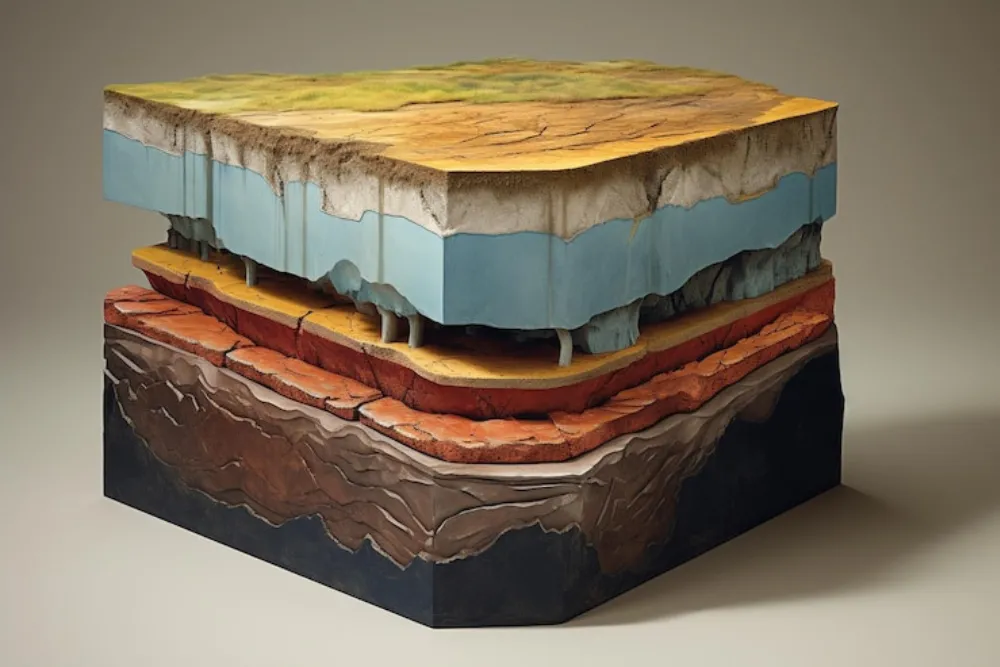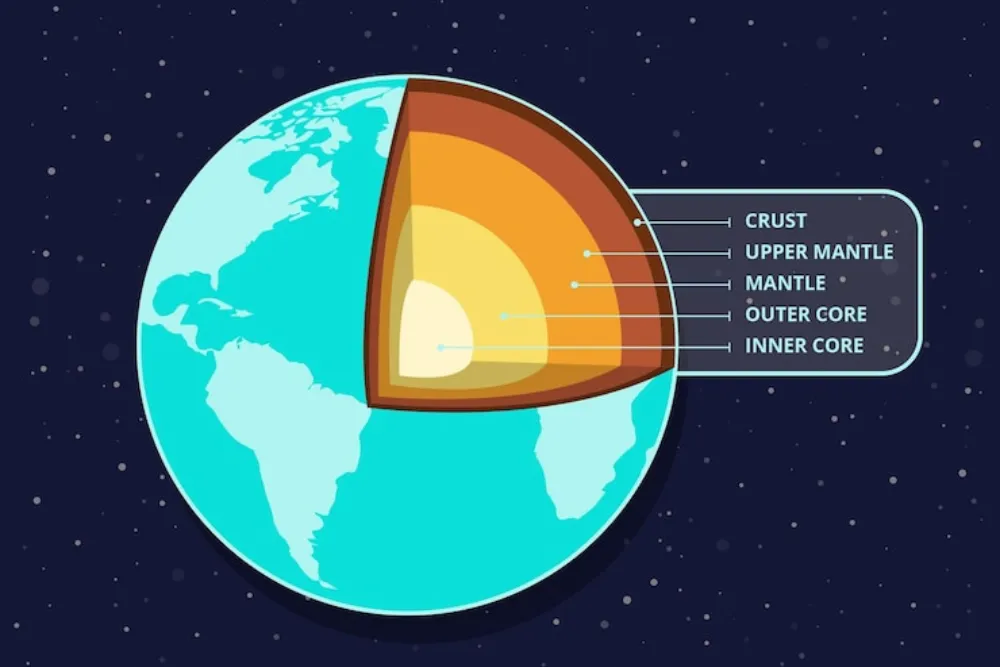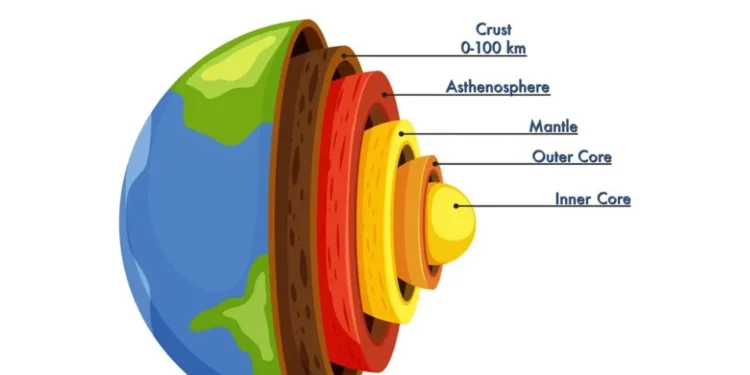In a rapidly growing world, science always comes with new unique, and eye-open inventions. Are we ever imagining humans travelling to the moon or in planes, cars, etc.? Have you ever imagined long distances becoming short by the story of the telephone, which has been modified with time and becomes the intelligent phone? On the other hand intelligence of humans has discovered that on which men live made many layers. Our planet, the Earth, is a dynamic and complex spherical with diverse strata that significantly impact its geological processes.
The following article offers an in-depth investigation of Earth’s information about Earth’s layers providing detailed information on their cosmetics, traits, and importance. We could adequately grasp the intricacy and distinctiveness of our sustainable world by learning more about these levels. Let’s see some information about earth’s layers . Earth and why our new generation should work and uncoil hidden facts related to information about earth’s layers.
Unknown History Of Earth Layers
Let’s start with some information about Earth’s layers. People have been keen on discovering how this planet formed and what made it up throughout the dawn of time. The earliest known examples are not scientific; they take the shape of myths about the creation or divine-centred religious stories. However, several hypotheses on the design of information about earth’s layers surface and its appropriate composition evolved between classical times and the Renaissance.

Ancient Ideas
Ancient Earth ideas preferred emphasizing the “Flat-Earth” theory concerning our planet’s structure. Based on the Mesopotamian civilization, the world was seen as an even circle floating in the sea. Four jaguars, known as bacabs, pulled up the sky at each corner of the Mayan globe, which they believed to be flat. The ancient Persians considered the Earth a seven-layered ziggurat (or cosmic mountain) and a four-sided cube by the Chinese.
Greek Study
Greek philosophers started to believe that the Earth was spherical around the sixth century BCE. By the middle of the third century BCE, the idea of a spherical Earth began to be stated as a scientific matter. In a similar time frame, philosophers began to build a geological information about earth’s layers, realizing that it was made up of metals and minerals and changed over very long periods.
But the real advancement in our knowledge of the planet and its structure occurred in the sixteenth and seventeenth centuries. Edmond Halley, who discovered Halley’s Comet, put forth what is now referred to as the “Hollow Earth” idea in 1692. He proposed that Earth is made up of a hollow shell around 500 miles thick and 800 kilometres wide in a manuscript sent to Statistical Transactions of the Royal Society of London.
He concluded that there was an equal-sized air gap around this and an inner spherical. He asserted that the inner sphere was maintained in place by the force of gravity to prevent the collision. The sizes of the planets Mercury, Venus, and Mars were represented by the model’s two inner concentric shells containing an innermost core.
Halley’s Theory
Halley’s build served as a way to explain why Sir Isaac Newton’s estimates of the relative densities of the Earth and the Moon in his Naturalistic Philosophy and Mathematical Principles (1687) were later proven to be incorrect. However, through the 17th and 18th centuries, his work was essential to advancing geography and hypotheses regarding the Earth’s innards.
The dispute around the integrity of the Holy Scriptures and the story of the Deluge during the eighteenth and nineteenth centuries was another significant element. This prompted discussions over the absolute age of the Earth among scientists and theologians, as well as the search for proof that the Great Flood took place. A systematic structure for classifying and dating the pressure on the planet’s strata started forming when mixed with the fossil evidence inside its layers.
The Modern Advances
Modern geology has also been influenced by advances in mining technology and a growing understanding of the value of commodities and their geographic distribution. Abraham Gottlob Werner, a German geologist, produced Von den äusserlichen Kennzeichen der Fossilien (On the External Qualities of Minerals) in 1774. This book provided a comprehensive system for classifying different minerals based on their outer properties.
This was made more accessible by the advancement of space travel, which made it possible to study Earth’s atmosphere in great detail and snap pictures of America from space. In 1972, the NASA and U.S. Geological Survey-managed Landsat Program began releasing satellite photographs that offered geologically detailed maps and were used to forecast catastrophes and plate tectonics. This is all about basic historical information about Earth’s layers.

The Outer Protective Covering (The Curst)
An essential source of information about Earth’s layers is the crust, which constitutes the body’s top layer. It has an average thickness of 5 to 70 kilometres, covering both the land surfaces and the ocean floor. The crust of minerals, rock types, and soil provides important clues about Earth’s geological past.
Granitic rocks make up the majority of the crust of continents, whereas basaltic stones make up most of the oceanic crust. In contrast to the oceanic crust, the continent’s crust is noticeably more robust, less dense, and older. Important hints about the past of the planet and present geological processes can be gleaned from understanding the structure and makeup of the crust.
The Middle Layer And Hot Dynamic Layer(The Mantle)
The mantle is a thick layer that extends to a depth of roughly 2,900 kilometres beneath the surface of the Earth. This layer mainly comprises dense but ductile rock material and contains information about Earth’s layers. The mantle makes up the majority of the volume of the Earth and is crucial in determining how our planet is shaped.
The upper mantle and lower mantle are two separate sections of the mantle. The lithosphere and the asthenosphere are the two parts of the upper mantle. The crust and the topmost layer of the mantle, divided into multiple tectonic plates, make up the lithosphere. Just beneath the lithosphere, in the asthenosphere, the motion of tectonic plates is facilitated by the asthenosphere’s semi-fluid properties.
Information about Earth’s layers gives us knowledge; the lower mantle is a solid layer that experiences rising pressure and temperature as it descends. The intense pressure in this area causes semi-fluid qualities despite its stable condition, leading to convection currents that propel plate tectonics and other geological occurrences.
The Innermost Core
The core, located in the centre of our planet, is a critical component of the Earth’s magnetic field and contains essential information about Earth’s layers. The Earth’s core is an area of enormous significance. It extends from about 2,900 kilometres to the planet’s centre, roughly 6,371 kilometres below the surface.
Information about Earth’s layers l The outer and inner core are two more layers that can be separated from the body. Mostly made up of liquid iron and nickel, the outer core is 2.300 kilometres thick. The region’s extreme heat and pressure keep the external core liquid, generating convection currents that produce the Earth’s magnetic field.
Other information about Earth’s layers The inner core, in comparison, has a solid circle with a radius of about 1,200 kilometres. Due to the intense pressure, the inner core, which is primarily made of solid iron and nickel, keeps its solid state despite the extremely high temperatures present here.
Exposing Relationships Between The End Of The World And Climate Change
The composition and processes within the Earth’s layers do not directly relate to the world’s end or global warming, but they can shed light on some geological events. Here are a few intriguing little-known facts regarding the strata of the Earth, so let’s explore some information about Earth layers with the end of the world as well climate change.
The uppermost layer of the Earth, the crust, does not have a constant thickness or makeup. Oceanic and continental crust are the two different forms of crust. The oceanic crust is thinner, with an average thickness of 5–10 kilometres, but the crust on land is thicker, averaging 30–50 kilometres.

The Earth’s Major Volume
The majority of the volume of the Earth is made up of the mantle, which lies under the crust. Although it is made of solid rock, it exhibits flexibility over geological timeframes, allowing solid material to move slowly. This movement—mantle convection—is fueled by the exchange of heat from the inside out and is essential for plate tectonics.
The outer core and the innermost part of the Earth are two separate components. The centre is solid due to tremendous pressure, despite having an extremely high temperature, while the outer core is mainly made of molten nickel and iron.
The crust and the topmost portion of the mantle are considered part of the lithosphere. It is separated into several tectonic plates, which float and migrate on the asthenosphere, a semi-fluid layer beneath. Plate tectonics, tremors, and volcanic activity result from the lithosphere’s interactions with the asthenosphere.
Mohorovii Discontinuity
The Mohorovii discontinuity, often known as Moho, separates the crust from the mantle. It was given this name in honour of the Croatian researcher Andrija Mohorovii, who made this seismic boundary discovery in 1909. Seismic wave velocity changes significantly at the Moho, signalling the move from the less solid crust to the denser beneath.
It’s crucial to remember that global warming and the world’s end are complicated and include many variables, including human activity, atmospheric conditions, and long-term climatic patterns. While the dynamics of our globe are influenced by the layers of the Earth and geological processes, human activity, such as emissions of greenhouse gases, deforestation, and pollution, is mostly to blame for the end of the world and global warming. Understanding the planet’s layers can help us better understand geological processes; however, tackling global issues requires coordinated action to reduce the effects of human activity on the environment.
Conclusion : Information About Earth’s Layers
In conclusion, exploring the little-known information about Earth’s layers shows fascinating parallels to global warming and the end of the planet. These urgent issues are intertwined with the integrity of the Earth’s crust, the delicate balance of the mantle, and the core’s protective function. Recognizing these relationships highlights the need to combat global warming, reduce carbon emissions, and safeguard the fragile balance of our planet’s geological systems.
We may work toward sustainable practices, environmental protection, and preserving our planet’s intricate layers by utilizing our knowledge of these hidden realities. Only by working together and practising good stewardship will we be able to protect our future and guarantee the survival of our extraordinary planet. This happens only when we have good or in-depth information about Earth’s layers.
Additional Notes
In addition to it, however, it is vital to understand that human activities, rather than the underlying makeup of the Earth, primarily affect the end of humanity, including global warming. Emissions of greenhouse gasses, deforestation, and pollution are some of the causes of the problems we currently face, such as warming temperatures and environmental degradation. Recognizing the layers of the Earth is crucial. Still, to solve these global problems, we must work together to lessen our impact on the environment, encourage sustainable behaviour, and implement efficient environmental information about earth’s layers.
We may work toward a more sustainable future and lessen the effects of human-induced climate change by combining the scientific understanding of the layers of the globe with collective action. We can preserve the Earth for future generations only if we have a solid understanding of the two processes, nature and human involvement. And all information about Earth’s layers. We should all spread information about Earth’s layers. And it now solely are hands how to protect our Earth. In the end, our young generation also studies as disciples on information about the Earth and explores more depth secrets of the universe. Students should try lunch awareness sessions related to this and motivate other students to research information about earth’s layers.




















